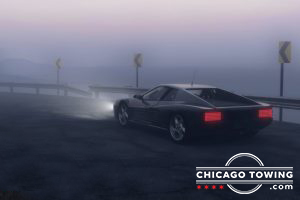Having your car break down on the road in the middle of the night compounds the normal stress of a car breakdown with the dangers of a breakdown in dark conditions. The reduced nighttime visibility adds a great deal of danger to your situation – so before you contact a towing company, follow these rules prepared by the experts at Chicago Towing as to how to remain safe during a nighttime breakdown.
Turn on Hazard Lights
It can be hard to determine how fast cars are moving at night – so make sure to turn on your hazard lights the second you notice that your car is behaving strangely, so as to notify any other drivers around you that you are moving at a weird speed and that they should drive with caution around you.
Get off the road
Get away from the road as soon as you can, as cars on the shoulders of the road are in more danger of getting hit especially during the nighttime. By pulling completely off the road, you are mitigating this dangerous risk.
Set your Location
It can be hard to notice nearby landmarks to help determine your location in the dark of the night, so use any GPS technology you might have to drop a pin and determine your exact location so you can notify your loyal towing company.
Call for Assistance
Contact a licensed towing company, and if you wish, contact the authorities to alert them of your situation and location in case you feel unsafe.
Leave the car from the passenger’s side
Since nighttime visibility is low, getting out of the driver’s side of the car can be dangerous, as there might be another car that will suddenly pass you. Even if you’re at the far side of the road, leave from your passenger’s side – but if your car is a safe distance away from the road, you can wait inside until help arrives.
Use Flares and/or Reflectors
Make sure that your car is outfit with an emergency kit of reflective triangles or road flares. Once you’ve pulled over to the side of the road, and left through the passenger’s side, make your car visible by placing reflective triangles and/or flares near your vehicle as well as 30 feet in front of and behind your vehicle, alerting all passersby to your presence.

